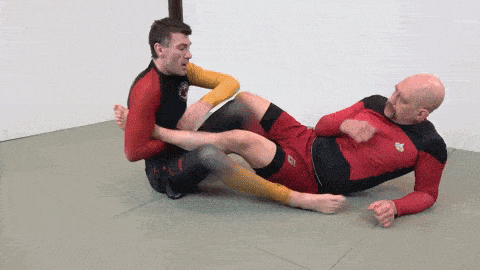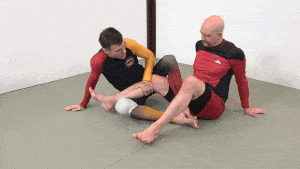
The Aoki lock is an incredibly versatile submission that can instantly turn the tables in a match.
You can apply it in situations where you have the dominant leglock position, but you can also use it as a counter when your opponent has the dominant position.
Either way, it’s a gamechanger!
Here’s a video from Cutting Edge Leglocks to break down the Aoki Lock for you, followed by a written summary of the main points. Enjoy this submission and apply it carefully!
Table of Contents
The Aoki Lock is NOT a Straight Ankle Lock
Many people think that the Aoki Lock is just a straight ankle lock applied sideways, but nothing could be further from the truth. These two submissions function very differently.
The straight ankle lock has two primary mechanisms that make people tap out: foot hyperextension and Achilles tendon compression.
Depending on the exact grip you are using, the size of your forearm, and the anatomy and pain tolerance of your opponent, he may feel one or both of these pressures at the same time.
The main point is that the straight ankle lock is a linear submission. It threatens to break your opponent’s foot in a straight line.

The Aoki lock, by contrast, is essentially an inside heel hook which is a submission that twists the leg in an outward direction. As such this attack can damage a number of ligaments in the foot and knee, and even result in broken bones in the ankle.
The rotational component makes the Aoki loc very powerful. This is why if you’re going for a straight ankle lock and I’m going for the Aoki lock then I’m almost certainly going to win unless there’s a huge strength, skill, or flexibility discrepancy between us.
3 Primary Situations
The Aoki lock can be used in a wide variety of situations and entanglements, but to get you started here are the three most common scenarios in which it gets applied…
Aoki Lock Setup 1, Opponent Tries to Pull His Foot Out

Often when you’re trying to control a leglocking position you’ll end up holding his foot with an overhook grip to control the end of the lever that is his leg. This is superficially similar to a straight ankle lock grip.
To escape an ankle lock grip it’s very common for your opponent to rotate his foot outward which then allows him to retract his leg and escape his heel through the space between your forearm and your ribs. This movement is shown above.
If you’re ready for this counter then you can shut it down by transitioning from the ankle lock grip to the Aoki lock grip. Essentially his escape movement gives you the exact angle you need to switch to an even more effective submission!
Aoki Lock Setup 2, Force the Rotation with Butterfly Hook

In this second setup, your opponent doesn’t pull his foot out; instead, you upgrade your position from an ankle lock to the Aoki lock.
You do this by bringing your outside foot to the inside and using your instep (your ‘butterfly hook’) to force his leg into an outwardly rotated position. From here, it’s easy to switch your grip and apply the Aoki lock as detailed below.
Aoki Lock Setup 3, To Counter His Leglock Attempt from Standard Ashi

In the two previous setups, the Aoki lock was applied from the dominant leglock position, specifically the ‘standard ashi’ and/or the ‘single leg x’ position. This setup is different because now you’re applying it as a counter when your opponent has a good leglock position.
In the example above, I (in the Star Trek rashguard) catch Rob in the standard ashi, intending to go for my own leglock. To my chagrin, Rob takes the foot pinning his hip and applies the Aoki lock to it.
This is just one example of how the Aoki lock is integral to the counter-leglocking game.
Arm Positioning for the Aoki Lock
Let’s say you’ve used one of the setups above to get to the position where your opponent’s foot is externally rotated. It would be best if you now controlled his foot so it couldn’t escape and so that you could attack it. Let’s break down the details…

Initially, you will control his instep with your biceps and armpit area and the Achilles tendon area with the meat of your forearm.
Pull UP on his foot, towards your face, to keep his foot secure. You’re not pulling up enough if his foot keeps slipping out in this position.

Next, take your hand and grasp the back of your other arm. Try to go deep, around the back of the triceps and don’t just have your hand resting on your biceps.
Sometimes, you may even bring your looping arm up onto your shoulder to take the slack out of the system.

Finally, you’ll lock the upper body position by cross-gripping your opposite triceps or shoulder with your loose arm. This creates a very tight lock on his foot, with his foot very strongly rotated outwards at the knee.
Leg Positioning for the Aoki Lock
In addition to locking your arms up (covered above), you must attach your legs to his hip.
Once you’ve attached to his hip and everything is tight, a tiny bridging motion will instantly make the Aoki lock come on.
There are many ways to immobilise his leg and attach to his hip – let’s review a few of the most commonly encountered ones…
Leg Position 1, You Have Him in Standard Ashi

In the photo above, Rob (yellow and red sleeves) has me (Star Trek rashguard) in the standard ashi leg position. He’s controlling my left leg with both of his legs and pinning my left hip with his right foot.
Leg Position 2, He Has You in Standard Ashi

In this example, I have Rob in standard ashi, but he’s managed to apply to Aoki lock to my left foot anyhow. This is a highly frustrating way to get caught in a submission.
Note: one way to prevent getting caught in this is to keep your inside knee glued to your outside foot when applying standard ashi. This makes it harder for him to dig for your outside foot and secure the correct arm position.
Leg Position 3, You Have Both Feet on His Belly

The Aoki lock is so powerful that you don’t need to have a whole entanglement in one of the recognised positions. In this example, Rob is simply putting both of his feet onto my belly and then bridging a little bit to get the finish.
Leg Position 4, Butterfly Hook Variations
The butterfly hook is commonly used with the Aoki lock (as in the second setup covered above). Typically you want your shin to be in the crook of his knee where it keeps his leg bent.
There are several different things you can do with your other leg though
One Hook behind the knee, the other foot on the floor.
This is the simplest example of using the butterfly hook to set up and apply the Aoki lock. The trouble is that nothing prevents him from elevating his hips (which reduces the power of your bridge) and rotating to his left (which undoes your leglock).

Butterfly Ashi.
In this example, you still have one hook behind the knee of the leg you’re attacking, but your other leg is draped over his hip. This makes it much harder for him to elevate his hips and spin.

Butterfly Ashi with One Foot on His Belly
A similar variation has your free leg stomping on his belly and/or hip. Once again, this prevents him from elevating his hip to relieve pressure and spinning to get out of the position.

More Leglocking Resources
The Main Positions of Modern Leglocking
If you study the positions in this book, you’ll have a vocabulary to understand the leglock exchanges you see in the highest levels of no gi competition (including ADCC coming up!).
For each position, you’ll get an idea of how to do it, your options, other names, and more.
Click here to download The Modern Leglock Position Cheatsheets for free.
The Modern Leglock Formula
This ultimate guide to leg locking in the modern era by these two well-known BJJ black belt instructors is available both as a 6-DVD set and in an online format that you can access instantly on your computer, phone, or tablet.
This resource will give you a proven, step-by-step system for safely adding ultra-effective lower body submissions to your game. Now you can add the same leglock techniques and strategies that have transformed the grappling scene to your submission arsenal.
Click here to learn more about what’s in The Modern Leglock Formula.
A Masterclass on Finishing the Heel Hook from the 411 Position
As heel hooks become more popular, people are getting better at defending them. Right now, the most common defence by far is to turn the hip and slip the knee out.
Here are three competition-proven ways to shut down this hip-turn escape and finish your opponent no matter how he tries to squirm out of your submission!
Click here to check out the escape and also the counters to the escape.
Cutting Edge Leglocks
Leglocks have changed the grappling game forever, and leglock attacks have never been more effective! But this area of jiu-jitsu is evolving FAST. Most grapplers need some help to keep up with the times and stay caught up.
In Cutting Edge Leglocks, renowned black belt instructors Rob Biernacki and Stephan Kesting guide you through the most effective techniques, strategies, transitions, defences, and recounters of the modern leglock scene in no gi competition.
This is no BS, to-the-point instruction with over 10 hours of content and zero filler (we don’t love the sound of our own voices that much). The rapid-fire, action-packed content makes this the most helpful leglock instructional you’ll ever see.
Click here for more information about what’s in the Cutting Edge Leglocks instructional.






